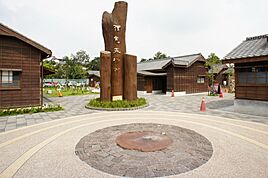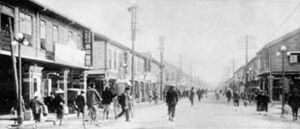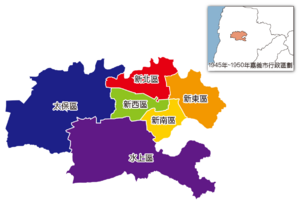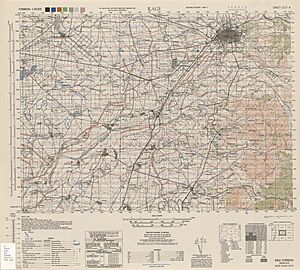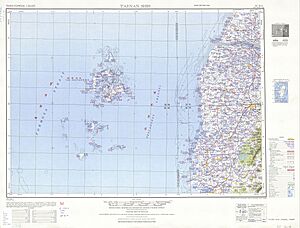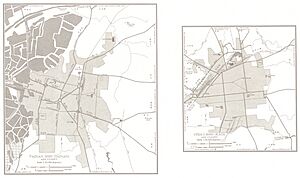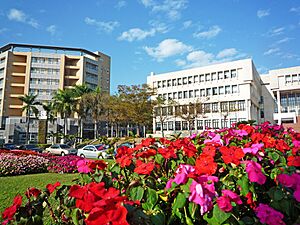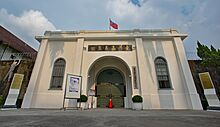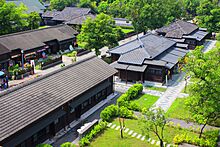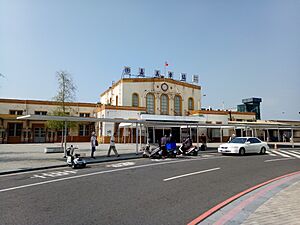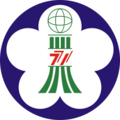Chiayi facts for kids
Quick facts for kids
Chiayi City
嘉義市
Ka-gi, Kagi, Chiai, Chia-i
|
|||
|---|---|---|---|
|
City
|
|||
| Chiayi City | |||
|
Clockwise from top left: Hinoki Village, Chiayi Confucius Temple, Fountain at the Lantan Reservoir, Chiayi City Sports Arena, Chiayi Municipal Culture Center, Chiayi Sun Shooting Tower, National Chiayi University
|
|||
|
|||
| Nickname(s):
Peach City (桃城) or Jia City (嘉市)
|
|||
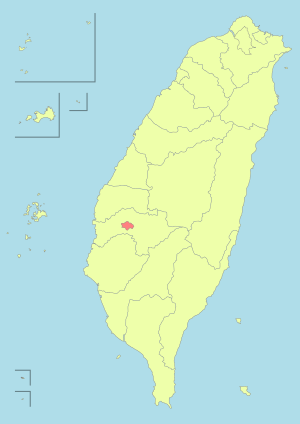 |
|||
| Country | |||
| Province | |||
| Region | Southwestern Taiwan | ||
| First mentioned | 1787 | ||
| Renamed to Kagi | 17 April 1895 | ||
| Autonomous city | 1930 | ||
| Provincial city | 25 October 1945 | ||
| Downgraded to county-administered city | 16 August 1950 | ||
| Provincial city status restored | 1 July 1982 | ||
| Seat | East District | ||
| Districts |
2 districts
East
West |
||
| Government | |||
| • Type | Chiayi City Government | ||
| Area | |||
| • Total | 60.03 km2 (23.18 sq mi) | ||
| Area rank | 21 out of 22 | ||
| Elevation | 69 m (226 ft) | ||
| Population
(January 2023)
|
|||
| • Total | 263,188 | ||
| • Rank | 18 of 22 | ||
| • Density | 4,384.3/km2 (11,355.2/sq mi) | ||
| Time zone | UTC+8 (National Standard Time) | ||
| Postal code |
600
|
||
| Area code(s) | 05 | ||
| ISO 3166 code | TW-CYI | ||
| Flower |
|
||
| Tree | Hong Kong orchid tree | ||
| Chiayi City | |||||||||||||||||||||||||||||||||||||||
|---|---|---|---|---|---|---|---|---|---|---|---|---|---|---|---|---|---|---|---|---|---|---|---|---|---|---|---|---|---|---|---|---|---|---|---|---|---|---|---|

"Chiayi" in Traditional (top) and Simplified (bottom) Chinese characters
|
|||||||||||||||||||||||||||||||||||||||
| Chinese name | |||||||||||||||||||||||||||||||||||||||
| Traditional Chinese | 嘉義市 | ||||||||||||||||||||||||||||||||||||||
| Simplified Chinese | 嘉义市 | ||||||||||||||||||||||||||||||||||||||
|
|||||||||||||||||||||||||||||||||||||||
| Japanese name | |||||||||||||||||||||||||||||||||||||||
| Kanji | 嘉義市 | ||||||||||||||||||||||||||||||||||||||
| Hiragana | かぎし | ||||||||||||||||||||||||||||||||||||||
| Katakana | カギシ | ||||||||||||||||||||||||||||||||||||||
|
|||||||||||||||||||||||||||||||||||||||
Chiayi (pronounced like "Jyah-ee"), officially known as Chiayi City, is a vibrant city in Taiwan. It is located in the southwestern part of the island, surrounded by Chiayi County. As of January 2023, about 263,188 people live here.
Chiayi is known for being the starting point of the Alishan Forest Railway. This railway takes you up to the beautiful Alishan National Scenic Area. The city has a warm, humid climate, especially in summer. You can still see many buildings and landmarks from when Japan ruled Taiwan.
Contents
- What's in a Name? The History of Chiayi's Name
- A Look Back: The History of Chiayi City
- Where is Chiayi City? Geography and Climate
- Learning and Green Energy in Chiayi
- Fun Places to Visit in Chiayi City
- Sports Events in Chiayi
- Famous People from Chiayi
- Chiayi's Sister Cities Around the World
- Getting Around: Transportation in Chiayi
- Images for kids
- See also
What's in a Name? The History of Chiayi's Name
Chiayi City has had a few different names over time. Its first name was Tirosen, given by the native Hoanya people. When Chinese settlers arrived, they called it Tsulosan. This name was later shortened to Tsulo.
In 1787, the city was renamed Kagee (which means "commended righteousness"). This name was given by the Chinese Emperor to honor the citizens. They showed great loyalty during a rebellion. Later, during Japanese rule, the city was called Kagi. After Taiwan became part of the Republic of China in 1945, it was officially named Chiayi City.
A Look Back: The History of Chiayi City
Early Beginnings and First Settlers
Long ago, the area of Chiayi was home to the Hoanya aboriginal people. They called their land Tirosen. Later, Chinese immigrants came to Taiwan. In 1621, a leader named Yen Ssu-chi brought people to settle and farm this land.
Under Dutch and Ming Rule
From 1624, the Dutch controlled parts of Taiwan. Their records often mention Tirosen. In 1661, a Chinese general named Koxinga defeated the Dutch. He set up the Kingdom of Tungning. Chiayi was then part of Tien-Hsing County.
The Qing Dynasty Era
In 1683, the Qing dynasty from China took over Taiwan. They created Tsulo County, which included a large part of northern Taiwan. In 1704, the main town of Tsulo County moved to where Chiayi City is today. The town even had wooden walls for protection.
In 1786, there was a big rebellion led by Lin Shuangwen. The people of Tsulosan bravely defended their city. Because of their loyalty, the Qing Emperor renamed the city Kagee in 1787. This name means "praised for righteousness."
Japanese Rule and Big Changes
In 1895, Taiwan became a territory of Japan. The city was then called Kagi. A strong earthquake in 1906 destroyed most of the city walls. The Japanese government rebuilt the city, and businesses began to grow. By 1904, Kagi was one of the biggest cities in Taiwan.
In 1907, construction began on the Alishan Forest Railway. This special railway connects Chiayi to the famous Mount Ali. In 1930, Kagi became an official city.
Chiayi in the Republic of China Era
After Japan left Taiwan in 1945, Chiayi became a "provincial city" of the Republic of China. This meant it was an important city with its own government. However, in 1950, its status was changed. It became a "county-administered city" and was joined with Chiayi County. This change slowed down its growth.
Local leaders worked hard to get its special status back. In 1982, Chiayi City once again became a provincial city. Today, it is divided into two main areas: the East District and the West District.
Where is Chiayi City? Geography and Climate
Chiayi City is located on the flat Chianan Plain in southwestern Taiwan. To the east, you can see the Mount Ali mountains. To the west is the Chiayi Airport. The city is surrounded by Chiayi County.
The city is about 15.8 kilometers (9.8 miles) from east to west. It is 10.5 kilometers (6.5 miles) from north to south. Its total area is about 60 square kilometers (23 square miles). Most of Chiayi City is flat, fertile land. The land gently rises from west to east. Chiayi is also very close to the Tropic of Cancer line.
Chiayi's Weather: A Humid Subtropical Climate
Chiayi City has a warm and humid subtropical climate. This means it has hot, wet summers and mild, drier winters. Most of the rain falls from June to August. This is because of winds coming from the southwest. In fall and winter, winds from the northeast bring less rain. The air is humid all year round.
| Climate data for Chiayi (1991–2020 normals, extremes 1968–present) | |||||||||||||
|---|---|---|---|---|---|---|---|---|---|---|---|---|---|
| Month | Jan | Feb | Mar | Apr | May | Jun | Jul | Aug | Sep | Oct | Nov | Dec | Year |
| Record high °C (°F) | 31.7 (89.1) |
33.0 (91.4) |
34.1 (93.4) |
34.2 (93.6) |
37.2 (99.0) |
37.0 (98.6) |
37.2 (99.0) |
36.6 (97.9) |
36.7 (98.1) |
36.5 (97.7) |
33.6 (92.5) |
32.5 (90.5) |
37.2 (99.0) |
| Mean daily maximum °C (°F) | 22.5 (72.5) |
23.0 (73.4) |
25.4 (77.7) |
28.4 (83.1) |
30.9 (87.6) |
32.8 (91.0) |
33.4 (92.1) |
32.8 (91.0) |
32.1 (89.8) |
30.1 (86.2) |
27.6 (81.7) |
23.9 (75.0) |
28.6 (83.4) |
| Daily mean °C (°F) | 16.8 (62.2) |
17.7 (63.9) |
20.2 (68.4) |
23.5 (74.3) |
26.3 (79.3) |
28.3 (82.9) |
28.9 (84.0) |
28.4 (83.1) |
27.4 (81.3) |
24.9 (76.8) |
22.0 (71.6) |
18.4 (65.1) |
23.6 (74.4) |
| Mean daily minimum °C (°F) | 12.9 (55.2) |
14.1 (57.4) |
16.2 (61.2) |
19.5 (67.1) |
22.6 (72.7) |
24.7 (76.5) |
25.4 (77.7) |
25.2 (77.4) |
24.0 (75.2) |
21.1 (70.0) |
18.0 (64.4) |
14.2 (57.6) |
19.8 (67.6) |
| Record low °C (°F) | 1.8 (35.2) |
2.6 (36.7) |
2.7 (36.9) |
8.2 (46.8) |
13.9 (57.0) |
17.5 (63.5) |
21.7 (71.1) |
19.7 (67.5) |
17.6 (63.7) |
11.5 (52.7) |
6.7 (44.1) |
0.4 (32.7) |
0.4 (32.7) |
| Average precipitation mm (inches) | 27.5 (1.08) |
44.9 (1.77) |
53.0 (2.09) |
86.6 (3.41) |
170.0 (6.69) |
318.6 (12.54) |
387.4 (15.25) |
443.8 (17.47) |
212.3 (8.36) |
30.2 (1.19) |
21.5 (0.85) |
25.8 (1.02) |
1,821.6 (71.72) |
| Average precipitation days (≥ 0.1 mm) | 5.1 | 5.5 | 6.8 | 8.1 | 10.4 | 13.8 | 15.3 | 17.9 | 9.4 | 2.9 | 3.3 | 4.1 | 102.6 |
| Average relative humidity (%) | 77.9 | 79.3 | 79.3 | 79.8 | 79.9 | 77.5 | 77.2 | 80.1 | 80.1 | 78.9 | 78.7 | 76.8 | 78.8 |
| Mean monthly sunshine hours | 161.4 | 139.7 | 157.9 | 157.0 | 175.5 | 186.6 | 206.4 | 182.2 | 186.2 | 197.0 | 158.9 | 159.2 | 2,068 |
| Source: Central Weather Bureau | |||||||||||||
Learning and Green Energy in Chiayi
Top Universities and Colleges
Chiayi City is home to several important schools. These include:
- National Chiayi University
- National Chung Cheng University
- Chung Jen College of Nursing, Health Science and Management
Promoting Green Energy
Chiayi City is working to be more environmentally friendly. In 2015, the city started a program to put solar panels on schools and government buildings. This helps reduce greenhouse gases. The program aims to produce a lot of clean electricity each year.
Fun Places to Visit in Chiayi City
Chiayi City has many interesting places to explore:
- Alishan Forest Railway & Railway Park: See old trains and learn about the famous mountain railway.
- Hinoki Village: A beautiful area with Japanese-style wooden houses.
- Chiayi Prison Museum: Learn about the history of this old prison, now a museum.
- Chiayi Park: A large park with several attractions inside.
- Chiayi Confucian Temple: A temple dedicated to the ancient Chinese teacher Confucius.
- Sun-Shooting Tower: A unique tower with a sun-themed design.
- Lantan Lake: A scenic lake perfect for a relaxing walk.
- Wenhua Road Night Market: A lively night market with lots of delicious food and shopping.
- Chiayi Cultural and Creative Industries Park: A place where old buildings are used for art and creative businesses.
- Chiayi Municipal Museum: Discover the history and culture of Chiayi.
- 228 Memorial Park: A park dedicated to remembering an important event in Taiwan's history.
Chiayi International Band Festival
Chiayi is known as the "city of wind music" in Taiwan. Every year, it hosts a big wind music festival. It started small in 1988. Now, it's one of the most exciting events in Chiayi. Bands from all over come to perform.
Sports Events in Chiayi
Chiayi City has hosted several exciting sports events, including:
- The 2001 Baseball World Cup (co-hosted with other cities).
- The 2012 Asian Soft Tennis Championship.
- The 2018 World University Baseball Championship.
Famous People from Chiayi
Many notable people have come from Chiayi City:
- Tan Ting-pho (1895–1947): A very famous Taiwanese painter.
- Vincent Siew (1939): A well-known Taiwanese politician who served as Vice President.
- Huang Min-hui (1959): A former mayor of Chiayi City.
- Wu Bai (1968): A popular Taiwanese rock singer.
Chiayi's Sister Cities Around the World
Chiayi City has special connections with other cities around the world. These are called "sister cities" or "twin towns." They share culture and friendship.
 East Orange, New Jersey, United States (1972)
East Orange, New Jersey, United States (1972) Jackson, Mississippi, United States (1972)
Jackson, Mississippi, United States (1972) Juneau, Alaska, United States (1977)
Juneau, Alaska, United States (1977) Murray, Utah, United States (1977)
Murray, Utah, United States (1977) Bulacan Province, Philippines (1980)
Bulacan Province, Philippines (1980) Martinsburg, West Virginia, United States (1988)
Martinsburg, West Virginia, United States (1988) Syracuse, New York, United States (1995)
Syracuse, New York, United States (1995) Hsinchu City, Taiwan (2002)
Hsinchu City, Taiwan (2002)
Getting Around: Transportation in Chiayi
Trains
You can travel to and from Chiayi City by train. The main stations are Chiayi Station and Jiabei Station. Chiayi Station is also where the Alishan Forest Railway begins its journey up the mountain. For faster travel, the THSR Chiayi Station (High-Speed Rail) is located nearby in Chiayi County.
Buses
Chiayi has a good bus system. The Chiayi Bus Rapid Transit connects the city to the High-Speed Rail station. Chiayi City Bus routes cover the urban areas, making it easy to get around.
Air Travel
For air travel, Chiayi City is served by Chiayi Airport. It is located in the nearby Shuishang Township.
Images for kids
See also
 In Spanish: Chiayi para niños
In Spanish: Chiayi para niños


